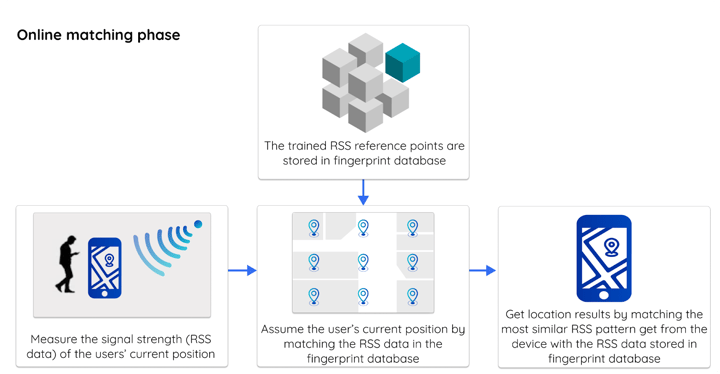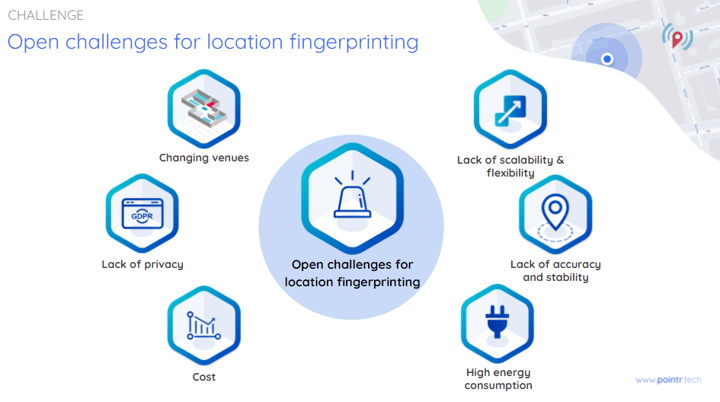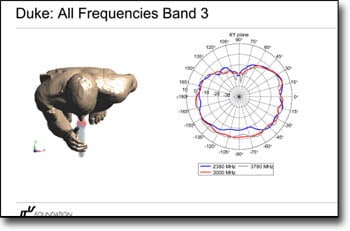Location fingerprinting - what is it, and should you choose it as your IPS technology?
Eva Cheng
Updated on 24/01/2025.
When choosing an indoor location provider, there are a few key elements that you need to look into: the accuracy of the blue dot, the scalability of the solution, the flexibility to adapt to an always-changing floor plan, and finally, ensuring there are real-world case studies to back the technology. Over the years, some companies have claimed they can achieve that by leveraging wireless fidelity via location fingerprinting, but can they back up their claims?
In this article, we'll explore what location fingerprinting is and whether it lives up to its hype. We'll also explain why at Pointr, we don't use location fingerprinting and how we achieve highly accurate and scalable location technology.
You'll discover
-
Insights into location fingerprinting, including a detailed explanation of what it is and how it works
-
The drawbacks of using location fingerprinting for indoor positioning and why Pointr avoids this technology
-
Real-world examples of location fingerprinting
-
How do we avoid the issues associated with location fingerprinting by using a completely different approach in the Pointr Deep Location®?
Location fingerprinting - what is it and how does it work?
Fingerprinting is a common indoor positioning technology to determine a user's position. The technique relies on signal strength data, called "RSS (Received Signal Strength)," which represents the distance of each beacon or sensor from a user's device.
This technique involves creating a signature of the venue by walking around the venue step by step and recording signals at every step. By turning the venue into a grid, it is possible to create a database of different signal strengths to know which signal strengths to attribute to each spot within a building.
By cross-referencing the Received Signal Strength Indicators (RSSI) against the pre-existing record, the system can assume the device's "live" position by calculating the distance between a beacon/ sensor and a user device using the fingerprint data when the system was first set up.
Location fingerprinting usually consists of two main phases - the offline training and the online testing phases.
The offline training phase trains the fingerprinting algorithm to learn the RSSI (Received Signal Strength Indicator) at various points, including "Access Points (APs)," "Reference Points (RPs"), and the "User Devices" - each of them acting as a landmark in the indoor environment. To train the algorithm, you need to physically walk around the venue and "record" the signal strength data on a mobile device. The collected data is then stored in a database along with their location coordinates, called "Reference Points."
-png.png)
|
What happens in the database
|
The online matching phase measures the RSSIs from beacons and compares them with the values stored in the database to infer a location. The Received Signal Strength (RSS) value obtained at any point in a location is called a location fingerprint.
When a user moves around the indoor environment, the following process will happen:
-
An access point (AP) or beacon sends the target signal
-
A user's device detects the emitted signal
-
APs record the signal strength and upload the fingerprints of a user's device (RSS value) to the database
-
The database matches the received reference points (user's device) with the stored ones (from the offline training phase) to estimate a device's "live" location

What signals can be used in conjunction with fingerprinting?
Technically speaking, any signal that has a relative strength can be used in a fingerprinting context. As long as the end device (normally a smartphone) can interpret the RSSI, it's possible to create a fingerprinted 'map' of a location. Additional pieces of data, such as angle and time of arrival (AOA and TOA, respectively) can further augment this data and provide more accuracy.
However, while any signal can theoretically be used for RSSI fingerprinting, fingerprinting-based positioning solutions are often marketed as being hardware-free or as leveraging a building's existing hardware, most commonly WiFi access points. It's for this reason that the fingerprinting is most often associated with geomagnetic or WiFi signals.
Systems that have been installed with the main purpose of achieving indoor positioning and navigation, such as Bluetooth Low Energy (BLE), UWB, or others, rarely leverage fingerprinting purely as their infrastructure enables more robust, accurate, and frictionless systems to be used.
We have a more comprehensive look at both geomagnetic-based and WiFi-based positioning systems elsewhere on the Pointr blog, as well as an entire downloadable guide on systems that purport to be 'hardware-free', which you can access by clicking here.
Regardless of which signal is used, location systems built upon a fingerprinted foundation tend to have the same pros and cons, which we'll look at in the next section.
The pros and cons of fingerprinting localization for indoor positioning
Fingerprinting is one of the most common positioning techniques in use today. Companies like Apple and Google use Wi-Fi fingerprinting to provide indoor location with 15-20 meters accuracy.
The main advantage of a fingerprinting system is that it's relatively straightforward technically. If enough beacons are calibrated correctly, then the algorithm only needs to look up multiple signal strengths and use those to triangulate a device's location. There are no complex algorithms required.
However, fingerprinting has numerous drawbacks compared to a complex location technology such as Pointr Deep Location®, which makes complex and real-time calculations as devices or users move throughout an indoor environment.
The main disadvantages include:
-
Fingerprinting is not suitable for venues that update their layout - to use location fingerprinting, you need to record the venue to collect the reference points physically. Suppose you own a building that require regular layout changes, e.g., hybrid workplaces, busy hospitals, retail floors, and airports. You would need to go through the recording process and re-calibrate the system each time you change the layout to ensure accuracy, making location fingerprinting impractical for venues that change regularly.
-
The technique only works online - that’s because the signature is kept on a server. This means if a visitor doesn’t have data or if there’s no signal in the user’s location, the system will have to wait until they are back online before they can load their location and provide wayfinding capabilities. This is an issue for areas with limited internet access where there is no signal, or at international airports, where visitors typically don’t have data.
![]()
-
Cumbersome to install and maintain - location fingerprinting is difficult to set up. It requires walking step by step to configure, and if there’s any mistake in the calibration, the entire process needs to be started again. It is also difficult to maintain as it needs to be recalibrated every time there is a small layout change, for instance when you move a metal cabinet or close an entrance.
-
Lack of accuracy and stability - the performance of fingerprint-based methods depends on the number of beacons or sensors (APs) to populate accurate signal strength readings (RSSI). As its performance relies on measuring the signal strength, some factors might affect its accuracies: radio interference caused by building material, layouts or object mobility (inc. human bodies), device orientation, RSSI consistency, and more APs deployed, it can cause overlapping radio channel issues.
Radio interference caused by building material. Source: Machine Learning-Based Indoor Localization Using Wi-Fi RSSI Fingerprints: An Overview |
Radio interference caused by moving objects (e.g. human bodies). Source: Swiss Federal Institute of Technology. |
-
Cost - In order to improve the accuracy and stability of the positioning, fingerprinting relies on increasing the number of APs. This can substantially increase positioning costs. However, the critical cost factor for fingerprinting technology relates to how susceptible fingerprinting is to any sort of layout change or alteration to signal strength (for example, putting up or removing a wall). Any such change can require a complete remapping of the area, which is a time, labor and cost intensive exercise to repeat often.
-
Not easily scalable - fingerprinting localization doesn't scale well for all of the reasons mentioned above - it would be a very difficult task to record signatures of dozens, hundreds, or even thousands of buildings in order to digitize them with indoor location services. In fact, there isn’t a single example of fingerprinting deployment at scale.

What are the real-world examples of location fingerprinting?
Companies have tried leveraging location fingerprinting for indoor location services and claim they can achieve a high-performance indoor positioning system. Let's take a look at some of the real-world examples:
Ekahau
As one of the largest Wi-Fi/WLAN Network suppliers globally, Ekahau has developed indoor location technology using location fingerprinting. They've been making very bold claims about accuracy and performance, and it seems that they are one of the market leaders for indoor tracking systems. However, the most significant pain points for location fingerprinting still remain - flexibility and scalability. When reconstruction happens, the users need to re-calibrate both the APs and the data, including conducting a full site survey and recording process to ensure the accuracy and consistency of its positioning systems.
Skyhook wireless
One of the pioneers in location positioning technology, Skyhook wireless has developed its indoor location technology using location fingerprinting with a mix of infrastructure, including Wi-Fi, GPS, and device sensors. Their solution claims to deliver 5-8 meters of accuracy but recommends having as many APs as referenced to ensure accuracy.
To solve the biggest challenge for location fingerprinting, they developed a self-healing database system to tackle scalability and flexibility issues, allowing the system to identify if a new AP is added or moved and reconfigure the positions of APs directly in the backend without the need to conduct physical recordings or calibrations on-site. However, spoofing APs increases the risk of jamming other APs and breaking down the system.
No location fingerprinting here at Pointr, 100% guaranteed!
Pointr doesn't use location fingerprinting - essentially, fingerprinting is challenging to set up and maintain, inaccurate, expensive, and incapable of scaling quickly and easily.
Instead, the Pointr approach to indoor positioning is to use machine learning algorithms to work out where the blue-dot should be and the correct path and orientation to lead the user (pathfinding), using calculations relating to signals emitted by beacons, sensors, Wi-Fi access points, and smart lighting.
Pointr's Deep Location® solution is smart enough to calculate the real-time location of a user directly on their device via Pointr SDK, which means it doesn't need to do any location fingerprinting. Pointr's solution can even work offline without any internet access, making it the best solution for areas like parking lots, basements, or places with limited internet access.
Pointr Deep Location® is also hardware agnostic, and it works with various wireless devices with Bluetooth function, including beacons, sensors, Wi-Fi AP, or intelligent lighting. It's is easy to deploy with the minimum maintenance requirement.
Our approach ensures the Pointr Deep Location® technology is cost-effective, accurate, and flexible enough to scale quickly while protecting your buildings from the risks associated with location fingerprinting.
|
Deep Location® |
Location fingerprinting |
|
|
Location accuracy |
< 1-3 meters, real-time |
5-8 meters, delayed (depend on signal strengths) |
|
Scalability |
Machine-learning based algorithm adapt to layout changes 100% |
Require on-site survey and data collection every time layout change |
|
Consistency |
Work in offline mode |
Need internet access |
|
Hardware requirement |
Hardware agnostic |
Only work with WiFi access points |
|
Time to deploy |
Hours |
Weeks or months |
|
Upkeep |
None |
Monthly maintenance |
|
Setup cost |
$ |
$$$ |
| Deep Location® is Pointr's ground-breaking take on indoor location and indoor navigation, which revolves around being scalable and software-focused. Our product can be deployed quickly in an indoor environment when compared to other solutions that don't have that depth of ability. |
Find out more in this 8-minute clip from the Mr. Beacon podcast
Related topics:
-
The impact of 5G on location technology: what’s real and what’s hype?
-
What is UWB? Everything you need to know about Ultra-Wideband.
-
Bluetooth vs Ultra-Wideband (UWB): which is best for indoor location systems?
-
How to Select the Right Infrastructure for Indoor Positioning?
-
Do Bluetooth and Bluetooth Low Energy (BLE) use phone data and battery?
Author:
 |
Les Blythe |
 |
Eva Cheng |
Eva Cheng
Eva is Pointr's Product Marketing Manager, meaning she's uniquely positioned to discuss the complex technology that powers Pointr's market-leading products in a way that dispels many of the myths around indoor mapping and location. She's also an expert in the indoor location market at large, making her an authority on the benefits and drawbacks of different and sometimes competing approaches to solving the challenges of accurate indoor positioning.





 Watch the interview
Watch the interview